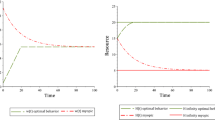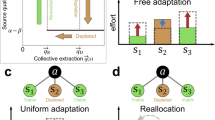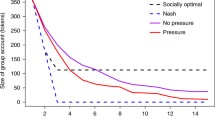Abstract
Most common pool resource (CPR) dilemmas share two features: they evolve over time and they are managed under environmental uncertainties. We propose a stylized dynamic model that integrates these two dimensions. A distinguishing feature of our model is that the duration of the game is determined endogenously by the users’ collective decisions. In the proposed model, if the resource stock level below which the irreversible event occurs is known in advance, then the optimal resource use coincides with a unique symmetric equilibrium that guarantees survival of the resource. As the uncertainty about the threshold level increases, resource use increases if users adopt decision strategies that quickly deplete the resource stock, but decreases if they adopt path strategies guaranteeing that the unknown threshold level is never exceeded. We show that under relatively high uncertainty about resource size, CPR users frequently implement decision strategies that terminate the game immediately. When this uncertainty is reduced, they maintain a positive resource level for longer durations.


Similar content being viewed by others
Notes
See, for example, Muradian (2001) for a survey of real world examples of ecosystems characterized by ecological discontinuities and uncertain threshold levels.
The use of the uniform distribution to model players’ imperfect knowledge about the resource is made primarily to simplify the experimental task, as the uniform distribution is most easily explained to the participants.
As noted by one of the referees, this feature of the game yields a large appropriation capacity to each player in the group. A design option modifying the Suleiman and Rapoport (1988) stage game (from which this feature is drawn) would be to limit each player’s appropriation to some fraction of β, which may be at odds with the possibility of unrestricted resource-use at the individual level. For example, if we think of this CPR as a groundwater system from which a group of n farmers pump water to irrigate their crops, and if each knows that the size of the groundwater system may go up to a number β, limiting a priori their water extraction to a fraction of β presupposes in itself that there is some technology limit common to them all or that there is some external regulator that has the ability to dictate and impose upon each of them such a limit. Therefore, we maintained this feature of the stage game in Suleiman and Rapoport (1988).
Although admittedly extreme, this rule accounts for a basic characteristic of a variety of ecological systems which can be exploited up to some critical (threshold) level while maintaining their integrity and retaining much of their use value. Once the exploitation level exceeds the (often largely uncertain) threshold, the resource value drops catastrophically, and may not be reversed even after stopping the perturbation that caused the shift during many years (Muradian 2001, pp. 18–19).
As noted, for example, by Hine and Gifford (1996), many real-world commons are characterized not only by pool-size uncertainty but also by regeneration-rate uncertainty. Although the present model focuses on pool-size uncertainty, it may also be seen as capturing those circumstances that are characterized by regeneration-rate uncertainty. When group requests exceed α but the resource is not depleted, the inter-temporal effect of group requests may be interpreted as captured by a stochastic regeneration rate g t applied to end of period remaining stock, \(s_{t} - \sum_{j=1}^{n} r_{jt}\). The parameter g t determines the stock available in the subsequent period, \(s_{t+1} =( s_{t} - \sum_{j=1}^{n} r_{jt} ) g_{t}\), where g t is uniformly distributed with limits endogenously determined by group requests and the stochastic resource size; its lower limit is given by \(\alpha/( s_{t} - \sum_{j=1}^{n} r_{jt} )\), which happens if the resource size in the subsequent period takes its lowest possible value, and its upper limit is given by \(\beta/( s_{t} - \sum_{j=1}^{n} r_{jt} )\), which happens if the resource size in the subsequent period takes its highest possible value.
At the end of each period, each subject was presented with a screen displaying her/his request in the period, the requests by each of the other group members, the total group request, the value of the random draw, and her/his payoff (in tokens) for the period. The instructions to participants are presented in Electronic supplementary material (ESM).
These numerical predictions result from the direct application of the solutions developed for the model in Sect. 3, which assumes that in determining the size of his or her request, the subject is motivated to maximize expected payoff. The generalization of the model to account for the maximization of expected utility is given in ESM, showing that, compared with the risk-neutral case, equilibrium requests are lower (higher) under the assumption of (common) risk-aversion (risk-preference) by subjects in both of the considered uncertainty conditions, leaving practically unaffected the predicted differences in equilibrium requests across the conditions. The main conclusion in the text with respect to the effect of different degrees of environmental uncertainty on subjects’ behavior does not depend on the assumed shape of the subjects’ (common) utility functions.
Because subjects participated in 30 repetitions/series of the same dynamic game, we first investigated whether play of the games changed as subjects gained more experience. A common finding in purely repeated CPR games is that behavior is consistent with efficient outcomes in the first rounds of play, and approaches the equilibrium prediction in the last rounds. Under this pattern of behavior, we would expect to observe longer games in the first series of play, and shorter games as the series approach the end. The figure in the ESM plots the maximum number of periods played by each group in each of the games, where the title in each of the panels identifies the uncertainty condition. In each case, the figure suggests that there is no systematic association between the length of the games and order of play. This impression was confirmed by several statistical analyses (available from the authors) at the group level. The same result occurs by regressing the natural logarithm of individual requests on dummy variables identifying each of the dynamic games, while controlling for group membership, the period within the game, and intra-subject correlation. Therefore, we pool the data across the games for the statistical analysis of the data in both uncertainty conditions.
As pointed out by one of the referees, because the observed effects at the group level could result from the mere aggregation of weak effects at the individual level, we also computed the per-period MSD of individual requests from predicted individual requests (either SPNE or SO) for each subject in each of the 30 played games. The results show that the SPNE path is the best predictor of individual behavior for 24 out of the 54 subjects (44.4 %) in the low-uncertainty condition, and for 36 out of the 60 subjects (60 %) in the high-uncertainty condition. In each case, these proportions do not differ from the observed proportion of groups with behavior closer to the SPNE path (4/9 and 8/10 in the low and high uncertainty conditions, respectively; the p-value of a proportions test is 0.23 in the high-uncertainty condition, not rejecting the null hypothesis that a proportion 8/10 is equal to a proportion of 36/60). Thus, the results at the individual level concur with those at the group level.
This result was confirmed by regressing the natural logarithm of group requests on a dummy variable identifying the experimental conditions, while controlling for each of the dynamic games, the period within the game, and intra-group correlation. The statistical significance of the difference in the length of the games between the experimental conditions was also confirmed by a random effects Poisson regression controlling for each of the dynamic games and intra-group correlation (random-effects).
A referee cautioned that although the efficiency index of the subgame perfect paths is approximately equal in the two uncertainty conditions, it is possible that the differences in α between them may have an important impact on behavior since the individuals’ choice of α/n is presumably less attractive as it moves to a smaller value. Accordingly, we would expect to observe subjects’ choice of the α/n=25 token value in the high-uncertainty condition to be less frequent than the subjects’ choice of the α/n=45 token in the low-uncertainty condition. While this behavioral hypothesis points to the development of different experimental treatments, we do not find this behavior in the current experimental data. In fact, the choice of the 25 token is observed in 8.24 % of all the individual decisions in the high-uncertainty condition, whereas the choice of the 45 token is observed in 4.89 % of all the individual decisions in the low-uncertainty condition. On the other hand, the choice of the β=850 tokens is more frequent in the high-uncertainty condition (representing 0.2 % all the individual decisions) than the choice of the β=730 tokens in the low-uncertainty condition (representing 0.09 % all the individual decisions). Because the choice of these extreme values is very rare in both conditions, we also computed the proportion of individual decisions falling above a 25 % bandwidth around the mean request of the respective group members; these decisions account for about 1/4 of all individual decisions in both conditions (26.97 % and 24.87 % in the high and low-uncertainty conditions, respectively), suggesting that the difference in aggregate outcomes between the conditions is not affected by different propensities to choose extreme values by the subjects in each condition.
These results stand in contrast with the findings from previous experimental implementations of Suleiman and Rapoport (1988)’s single-stage game. Using uncertainty ranges of 500 and 750 tokens (similar to the 460 and 700 uncertainty ranges used in the present conditions), Rapoport and Suleiman (1992) report mean requests supporting the respective Nash equilibrium solutions, implying differences in destruction probabilities consistent with the equilibrium solutions.
References
Bailey, M., Sumaila, U. R., & Lindroos, M. (2010). Application of game theory to fisheries over three decades. Fisheries Research, 102, 1–8.
Barrett, S., & Dannenberg, A. (2012). Climate negotiations under scientific uncertainty. Proceedings of the National Academy of Sciences of the United States of America, 109(43), 17372–17376.
Brown, G. M. (2001). Renewable natural resource management and use without markets. Journal of Economic Literature, 38, 875–914.
Budescu, D. V., Rapoport, A., & Suleiman, R. (1995). Common pool resource dilemmas under uncertainty: qualitative tests of equilibrium solutions. Games and Economic Behavior, 10, 171–201.
Clarke, H. R., & Reed, W. J. (1994). Consumption/pollution tradeoffs in an environment vulnerable to pollution-related catastrophic collapse. Journal of Economic Dynamics & Control, 18, 991–1010.
Dutta, P. (1995). Collusion, discounting and dynamic games. Journal of Economic Theory, 66, 289–306.
Fischbacher, U. (2007). Z-Tree: Zurich toolbox for ready-made economic experiments. Experimental Economics, 10(2), 171–178.
Gardner, R., & Walker, J. M. (1992). Probabilistic destruction of common-pool resources: experimental evidence. The Economic Journal, 102(414), 1149–1161.
Gordon, H. S. (1954). The economic theory of a common property resource: the fishery. Journal of Political Economy, 62, 124–142.
Gustafsson, M., Biel, A., & Garling, T. (1999). Overharvesting of resources of unknown size. Acta Psychologica, 103, 47–64.
Hardin, G. (1968). The tragedy of the commons. Science, 162, 1243–1248.
Herr, A., Gardner, R., & Walker, J. M. (1997). An experimental study of time-independent and time-dependent externalities in the commons. Games and Economic Behavior, 19(1), 77–96.
Hey, J. D., Neugebauer, T., & Sadrieh, A. (2009). An experimental analysis of optimal renewable resource management: the fishery. Environmental & Resource Economics, 44, 263–285.
Hine, D. W., & Gifford, R. (1996). Individual restraint and group efficiency in commons dilemmas: the effects of two types of environmental uncertainty. Journal of Applied Social Psychology, 26, 993–1009.
Koundouri, P. (2004). Current issues in the economics of groundwater resource management. Journal of Economic Surveys, 18, 703–738.
Mason, C. F., & Phillips, O. R. (1997). Mitigating the tragedy of the commons through cooperation: an experimental evaluation. Journal of Environmental Economics and Management, 34(2), 148–172.
Messick, D. M., & McClelland, C. L. (1983). Social traps and temporal traps. Personality & Social Psychology Bulletin, 9, 105–110.
Muradian, R. (2001). Ecological thresholds: a survey. Ecological Economics, 38, 7–24.
Oehlert, G. W. (1992). A note on the delta method. American Statistician, 46, 27–29.
Osés-Eraso, N., Udina, F., & Viladrich-Grau, M. (2008). Environmental versus human-induced scarcity in the commons: do they trigger the same response? Environmental & Resource Economics, 40, 529–550.
Ostrom, E., Gardner, R., & Walker, J. (1994). Rules, games, & common-pool resources. Ann Arbor: University of Michigan Press.
Papke, L. E., & Wooldridge, J. M. (1996). Econometric methods for fractional response variables with an application to 401(K) plan participation rates. Journal of Applied Econometrics, 11, 619–632.
Rapoport, A., & Suleiman, R. (1992). Equilibrium solutions for resource dilemma. Group Decision and Negotiation, 1, 269–294.
Reinganum, J. F., & Stokey, N. L. (1985). Oligopoly extraction of a common property natural resource: the importance of the period of commitment in dynamic games. International Economic Review, 26(1), 161–173.
Shapley, L. (1953). Stochastic games. Proceedings of the National Academy of Sciences of the United States of America, 39, 1095–1100.
Sobel, M. J. (1971). Noncooperative stochastic games. The Annals of Mathematical Statistics, 42, 1930–1935.
Suleiman, R., & Rapoport, A. (1988). Environmental and social uncertainty in single-trial resource dilemmas. Acta Psychologica, 68, 99–112.
Tsur, Y., & Zemel, A. (1995). Uncertainty and irreversibility in groundwater resource management. Journal of Environmental Economics and Management, 29, 149–161.
Yin, R., & Newman, D. H. (1996). The effect of catastrophic risk on forest investment decisions. Journal of Environmental Economics and Management, 31, 186–197.
Author information
Authors and Affiliations
Corresponding author
Additional information
We thank the two reviewers and Associate Editor for constructive remarks. This study was conducted while Botelho and Pinto spent a sabbatical leave at the Water Science and Policy Center, University of California, Riverside, and University of Arizona. Botelho and Pinto thank the Fundação para a Ciência e Tecnologia for sabbatical scholarships SFRH/BSAB/1226/2012 and SFRH/BSAB/1159/2011, respectively.
Electronic Supplementary Material
Below is the link to the electronic supplementary material.
Rights and permissions
About this article
Cite this article
Botelho, A., Dinar, A., Costa Pinto, L.M. et al. Time and uncertainty in resource dilemmas: equilibrium solutions and experimental results. Exp Econ 17, 649–672 (2014). https://doi.org/10.1007/s10683-013-9388-2
Received:
Accepted:
Published:
Issue Date:
DOI: https://doi.org/10.1007/s10683-013-9388-2




